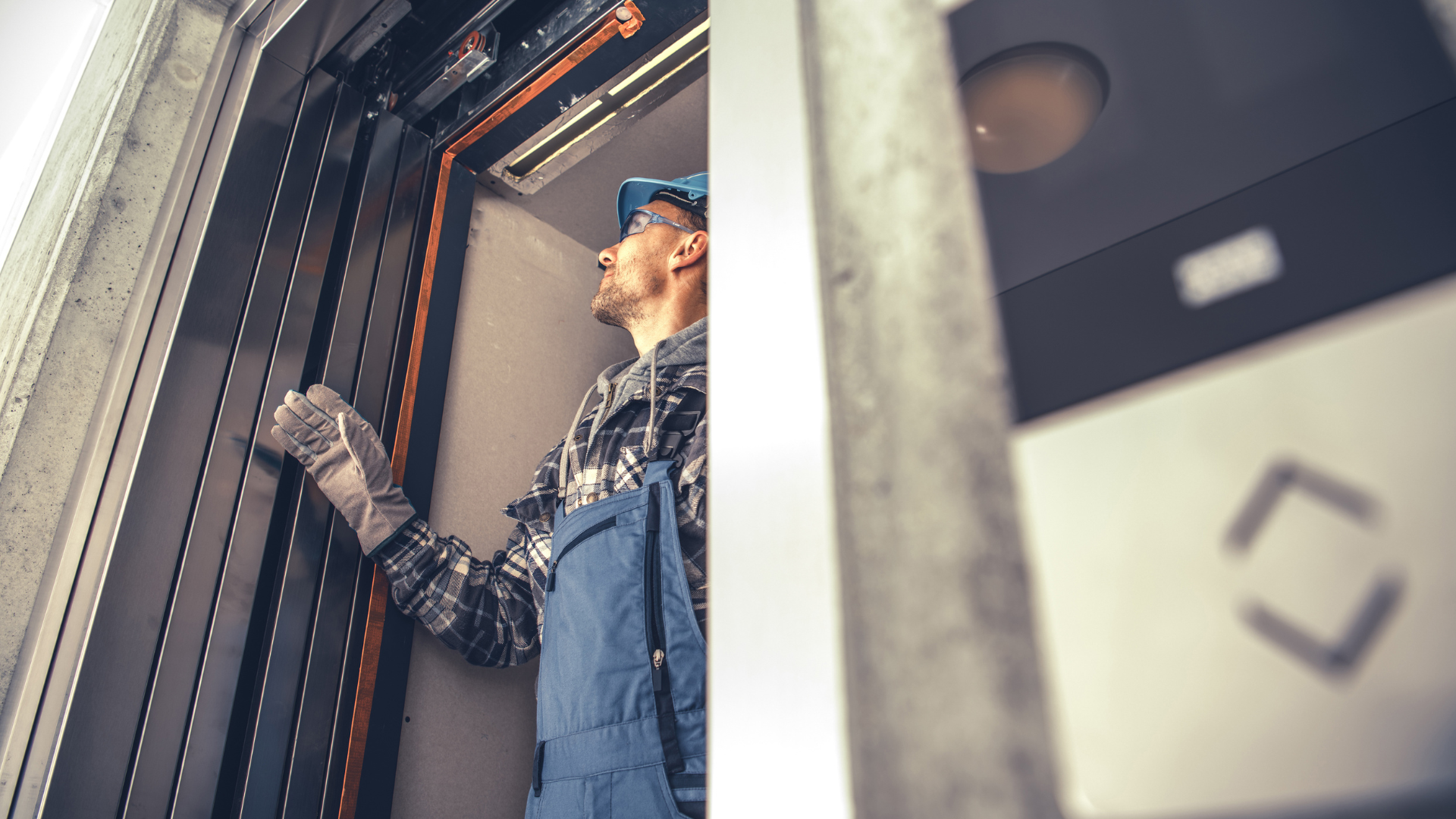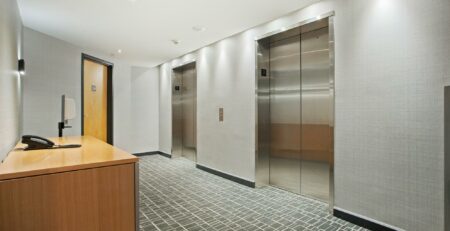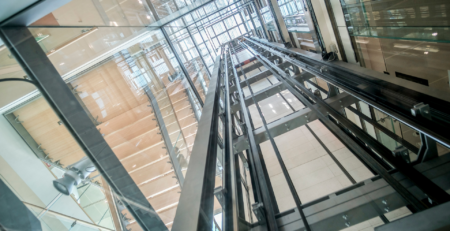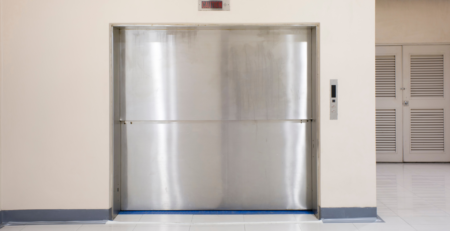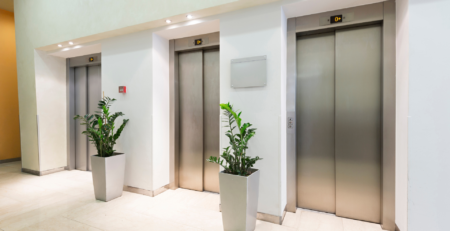Installing An Elevator – What You Can Expect
Deciding to install an elevator can be a big step. One key fact is that this process requires expert help from start to finish. Our article will guide you through what to expect, making things clearer and easier for you when it comes to installing an elevator. Keep reading for insights that light the way.
Key Takeaways
- Experts first check the building to make sure it can handle a new elevator by looking at its structure. If needed, they fix or strengthen parts of the building.
- Teams install key elevator parts like rail brackets and guide rails carefully, making sure everything is aligned and secure for smooth rides.
- Electrical work is crucial for connecting the elevator to the building’s systems, ensuring it works right with things like access control for safety and efficiency.
- After putting in all parts of the elevator, such as carriage and gates, final checks are done. These include safety tests and making sure everything meets guidelines.
- Regular maintenance keeps elevators running well over time. This involves routine checks and repairs to avoid big problems later on.
Importance of elevators in commercial buildings
Elevators play a crucial role in commercial buildings by enhancing accessibility and efficiency. They offer vital vertical transportation solutions for both visitors and employees, ensuring seamless movement between floors.
Elevator installation, being a complex process as highlighted, demands expertise to align with building codes and safety standards. Elevators are the backbone of modern commercial properties, facilitating easier access and functional design.
For commercial property managers aiming for modernization or constructing multistory buildings, incorporating passenger elevators is essential. These installations not only meet legal accessibility requirements but also significantly increase a property’s appeal to potential tenants.
A smooth elevator operation requires regular maintenance, underscoring the importance of selecting experienced professionals for both installation and ongoing care.
Evaluating the Building Structure and Support
Before installing an elevator, experts first assess the building’s structure to ensure it can support the new system. This step might involve making repairs or adding reinforcements to keep everything safe and secure.
Conducting a structural assessment
A structural assessment is crucial before installing an elevator in a commercial building. The process starts with a thorough site inspection to evaluate the layout, available space, and the building’s structural requirements.
This step ensures that the installation plan aligns perfectly with the building’s architecture and support systems. Expert engineers lead this assessment, utilizing their knowledge in structural engineering to pinpoint any potential issues that could hinder the installation.
Following the initial evaluation, the elevator company provides a detailed proposal. This document outlines everything from the scope of work to timelines and cost estimates. It serves as a roadmap for managers, highlighting necessary repairs or reinforcements that must be addressed before proceeding further.
This proactive approach minimizes surprises during installation by ensuring all structural prerequisites are met—a key factor in streamlining elevator integration into existing structures efficiently and safely.
After conducting a thorough structural assessment, it becomes clear what repairs or reinforcements are needed. Ensuring the building can support an elevator involves detailed planning and precise execution.
Installing the Elevator Components
Expert teams proceed with precision during the component installation stage of elevator setup. They start by securing rail brackets and guide rails, crucial for the smooth operation of the elevator.
Installing rail brackets and guide rails
Installing the right rail brackets and guide rails is crucial for the smooth operation of your elevator. This process ensures stability and precision in the elevator’s movement, meeting both safety regulations and performance standards. Here’s how to proceed:
- Start by selecting high – quality rail brackets compatible with your building’s structure. These brackets will support the guide rails and ensure that the elevator car travels efficiently between floors.
- Securely mount the rail brackets to the elevator shaft walls at specific intervals. This spacing is critical for maintaining the alignment of the guide rails and ensuring a stable path for the elevator car.
- Attach guide rails to these brackets using bolts or welding, depending on your system’s requirements and the materials used. The correct attachment method guarantees durability and operational integrity.
- Ensure precise leveling of each section of guide rails before final fixation. Even minor deviations can affect ride quality and increase wear on mechanical components.
- Conduct a thorough inspection after installing rail brackets and guide rails. This step confirms correct installation, alignment, and secure mounting necessary for safe operation.
- Integrate mechanical components such as rollers or shoes onto the elevator car, allowing it to interact smoothly with the newly installed guide rails.
- Adhere strictly to safety regulations throughout this process, verifying that all installed components meet relevant performance standards.
- Undertake rigorous testing upon completion to certify that everything functions as intended under typical operating conditions.
- Plan for regular maintenance checks post – installation to catch any issues early on, ensuring longevity and reliability of your elevator system.
- Stay informed about advances in technology or updates in safety standards that could necessitate future adjustments or upgrades to rail brackets and guide rails.
This step-by-step approach offers a clear path forward for commercial property managers overseeing an essential phase in installing elevators within their buildings.
Fitting the elevator drive
Fitting the elevator drive is a crucial phase in the elevator installation process. It involves connecting mechanical components and ensuring that the system runs smoothly and safely. Here’s how commercial property managers can expect this step to unfold:
- Select the type of drive system suitable for your building. Options include traction, hydraulic, pneumatic, cable-drum, and chain-drive elevators. Each has its benefits and fits different building requirements.
- Prepare the elevator shaft for installation. This entails creating enough space for not only the drive but also for other components like cables or hydraulic systems.
- Mount the motor and machinery. This step varies significantly depending on the chosen drive system but generally involves securing heavy equipment in place, often at the top of the shaft for traction elevators or at the bottom for hydraulic types.
- Connect electrical wiring to power up the drive system. Electricians will carefully integrate wires and connectors to supply power to the motor and control systems.
- Install safety mechanisms such as brakes and buffers. These are essential for preventing accidents by stopping or slowing down the elevator under specific conditions.
- Calibrate control systems to ensure smooth operation of the elevator drive mechanism. This includes adjusting speed settings, alignment, and response times to input from control panels or signal systems.
- Test run the elevator with load tests to verify stability and operational efficiency before it is officially opened for use within the building.
This comprehensive approach ensures that fitting an elevator drive component adheres strictly to safety standards while providing optimal performance in moving people efficiently across different floors of a commercial building.
Installing the carriage and gates
Installing the carriage and gates during an elevator installation marks a crucial step in ensuring the functionality and safety of the system. Qualified technicians, electricians, and engineers work together to deliver and install the essential components on site, ensuring everything aligns with industry standards.
- Prepare the elevator shaft by ensuring it’s clean, dry, and free from obstructions. This preparation lays a solid foundation for a smooth installation process.
- Position rail brackets within the shaft at specific intervals to support the guide rails effectively. These brackets must be securely attached to the shaft walls to bear the weight of the moving elevator car.
- Mount guide rails vertically in the elevator shaft, ensuring they are perfectly aligned for smooth travel of the carriage. Precise alignment prevents future operation issues or unnecessary wear on components.
- Assemble the elevator car or carriage on site before installing it into the shaft. Technicians meticulously piece together each part of the car, following detailed schematics for accuracy.
- Lift and place the assembled carriage onto its tracks inside the shaft with precision equipment designed for heavy lifting, adjusting its position until it sits correctly on guide rails.
- Install hoistway doors at each floor entry point in alignment with where entrances to the elevator car will be when it stops at that floor. Secure placement ensures safe boarding and disembarking from the elevator.
- Attaching all safety mechanisms and checks associated with opening and closing gates ensures that they operate seamlessly in conjunction with both carriage movement and user interaction.
- Connect electrical wiring to power both mechanical movements of gates and indicator lights signaling elevator positions across floors.
- Test gate mechanics extensively, focusing on their interlock system with carriage movement ensuring that doors can only open when safe to do so contributes critically towards overall safety protocols.
- Perform final adjustments based on test results adjusting any alignments or recalibrating sensors as needed guarantees smooth operation from day one.
Incorporating these steps not only highlights a meticulous approach toward installing critical components like carriages and gates but also underscores an unyielding commitment towards safety, reliability, and efficiency in elevator operations suited for commercial buildings.
Electrical Wiring and Integration
Installing the necessary electrical components and integrating them with your building’s systems ensures your elevator works seamlessly with modern access control technologies. Explore how this critical step brings smart functionality to elevators, enhancing safety and efficiency in commercial properties.
Installing the necessary electrical components
Installing the necessary electrical components is a crucial step in elevator installation, requiring a dedicated team of qualified electricians. This phase ensures that your elevator functions seamlessly, integrating with your building’s systems for efficient operation.
- Electrical Wiring Installation: First, electricians lay out and install wiring throughout the elevator shaft and machine room. They ensure that all cables are appropriately secured and protected to prevent any electrical hazards.
- Electrical Component Assembly: Next, the team assembles and mounts electrical components like the motor controller, signal fixtures, and operation panels. Each piece is carefully connected to the wiring system according to precise specifications.
- Elevator Electrical Setup: The electrical setup includes configuring the elevator’s power supply to match its operational needs. This step may involve adjusting settings on the motor controller and ensuring that all components receive adequate power without overloading the system.
- Wiring and Electrical Component Testing: After installation, each electrical component undergoes thorough testing. Electricians check for proper connections, test the functionality of signal fixtures and buttons, and ensure that emergency systems like alarms work correctly.
- Integration with Building Systems: Elevators often need integration with building access control or fire alarm systems. This step involves connecting these systems to allow smooth interaction. For instance, ensuring that an activated fire alarm can send elevators to a designated floor for evacuation purposes.
- Final Electrical Inspection: A final inspection by a certified inspector might be required to ensure that all installed electrical components meet local safety codes and regulations. This verification provides peace of mind that your elevator system is safe for occupants.
Each of these steps requires meticulous planning and execution by experienced professionals who understand both mechanical structures’ complexities and necessary electrical work for elevators.
Integration with access control and other systems
Integration with access control and other systems demands precise coordination between elevator installation teams and building security personnel. This process ensures that the new or updated elevator seamlessly communicates with existing security frameworks, offering enhanced control over who can access different floors within a commercial property.
Expertise in electrical wiring and system integration plays a crucial role here, making it essential to employ professionals proficient in connecting these complex networks.
Elevator companies typically provide thorough proposals that detail the scope of work, including how the integration will occur, its timeline, and cost estimates. This meticulous planning is vital for preventing any disruptions to daily operations while ensuring all systems operate harmoniously post-installation.
Proper integration enhances building security and efficiency, reflecting the importance of selecting an experienced installer familiar with both elevators and access control mechanisms.
Final Steps and Considerations
Ensuring a smooth elevator installation process culminates in rigorous final checks, commitment to regular maintenance, and understanding the significant influence on building dynamics; explore more to navigate these crucial steps effectively.
Conducting final checks
Installation of an elevator marks a significant upgrade for any commercial building. It requires careful attention to safety regulations and performance standards to ensure the safety and efficiency of the new system. Conducting final checks is a critical step in this process, confirming that the elevator meets all necessary criteria before it becomes operational. Here’s how you can effectively manage these final evaluations:
- Review Compliance with Elevator Safety Guidelines: Start by ensuring that the installed elevator adheres strictly to established safety guidelines. Check every detail against the regulatory requirements for elevators to confirm full compliance.
- Perform Thorough Testing Procedures: Implement a series of rigorous testing procedures designed to assess the elevator’s performance under various conditions. This includes load tests, emergency brake tests, and speed control tests to guarantee safe and smooth operation.
- Carry Out a Detailed Elevator Inspection Process: Arrange for an official inspection by certified professionals who specialize in elevator safety compliance measures. They will examine mechanical components, electrical systems, and safety features to ensure everything is up to standard.
- Implement Safety Checks for Elevators: Run comprehensive safety checks focused on emergency systems, such as alarms, communication devices, and power backups. Verify that these systems function correctly to provide maximum safety for users in all situations.
- Assess Quality Assurance Measures: Evaluate the quality of all installed components and workmanship during the installation process. High-quality materials and precise assembly are crucial for long-term reliability and performance.
- Schedule Regular Maintenance and Inspection: Establish a routine maintenance schedule based on manufacturer recommendations and regulatory requirements for elevators. Regular upkeep is essential for sustained safe operation and compliance with elevator inspection regulations.
- Verify Integration with Building Systems: Ensure that the elevator’s electrical wiring integrates flawlessly with existing building systems, including access control and emergency response mechanisms. Proper integration enhances functionality and user experience.
- Document Performance Standards Compliance: Keep detailed records showing that your elevator installation meets or exceeds all applicable performance standards for elevators. This documentation is invaluable for future inspections, maintenance decisions, and potential upgrades.
Executing these final checks meticulously positions your commercial property as a model of modern efficiency and stringent safety adherence concerning elevator installations.
Maintenance and ongoing care
Elevator upkeep goes beyond the initial installation; it involves routine inspections and regular servicing to ensure safety and smooth functioning. These preventative maintenance measures detect issues early, saving costs on major repairs down the line.
Elevator functionality is crucial for commercial buildings, necessitating ongoing care to avoid disruptions in daily operations. Continuing maintenance is not an expense but an investment in safety and efficiency.
Impact on building design and operations
Installing an elevator significantly changes how a building is designed and operates. Architects must now consider the additional space needed for the elevator shaft, machinery, and equipment rooms.
This adjustment often leads to rethinking floor plans to accommodate these requirements without sacrificing valuable square footage. Operations-wise, property managers need to integrate elevator access control with their existing security systems, ensuring seamless operation that enhances mobility solutions without compromising safety.
The introduction of a residential lift into a commercial setting not only increases property value but also promotes universal design principles, making buildings more accessible and adaptable for aging populations or those with mobility issues.
Managers face the task of maintaining these vertical transportation systems, which involves regular inspections and servicing to comply with safety standards. This maintenance ensures reliable home improvement solutions that cater to adaptive living accommodations while boosting overall efficiency in building operations.
Contact Toledo Elevator for Your Elevator Installation
Elevating your commercial building with an elevator adds immense value and functionality. From the initial building assessment to the final installation stages, each step requires precision and expertise.
Commercial property managers now understand the timeline, costs, and regulations involved in this complex process. Questions on practicality or efficiency find their answers in a structured approach to installation and maintenance.
The impact of integrating smart technology elevators into modern buildings cannot be overstated. For those looking to advance their properties, exploring further services and advancements in elevator technology is a wise next step.
Let this guide serve as your roadmap for transforming vertical transportation within your building, ensuring safety, efficiency, and future-readiness at every level. Contact Toledo Elevator today to see how we can help with your next project!
FAQs
1. How long does it take to install an elevator?
Installing an elevator usually takes a few weeks, depending on the complexity of the project.
2. What kind of maintenance does an elevator require?
Regular maintenance by professionals is required to keep your elevator running smoothly and safely.

Sammy Assaf leads Toledo Elevator, setting the bar high in the elevator service industry with innovative solutions and unmatched customer service. Sammy’s extensive knowledge of elevator systems, combined with a dedication to safety and efficiency, ensures Toledo Elevator offers comprehensive services that meet the modern demands of building management. The company prides itself on advancing elevator technology and maintenance, providing valuable insights into the latest trends and safety standards to keep elevators running smoothly and safely.

